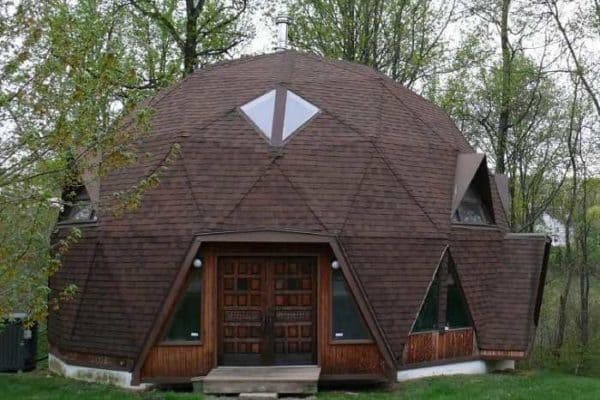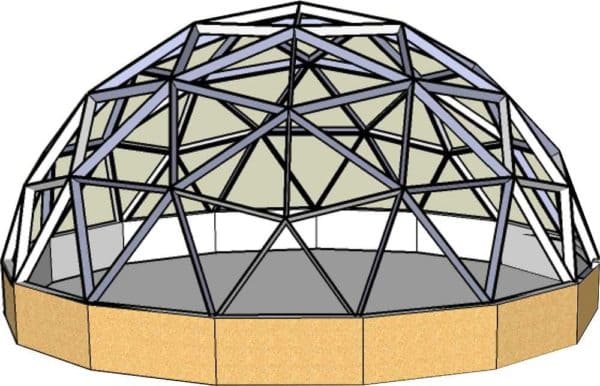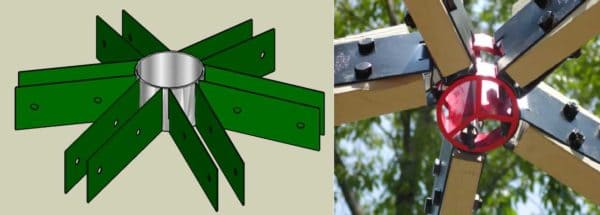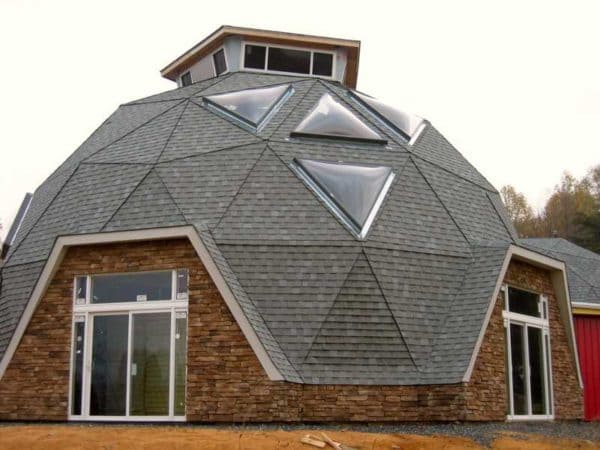Spherical (dome) houses: designs, layout features
Spherical, domed dwellings have been known for a long time — yarangs, plagues, wigwams, etc. — built on this principle. They are distinguished by their high stability and ease of construction, which earned the popularity of our ancestors. But domed houses in their pure form, as a phenomenon of modern construction, appeared not so long ago — about the second half of the last century. When the American scientist Fuller decomposed the dome structure into simple shapes — triangles, from which the entire structure is often assembled. It is on this principle that many spherical houses are built todayDomed houses: technologies and their features
A domed or spherical house is the name of a construction technology. Actually, the name reflects the peculiarity of this type of housing construction — the house is not rectangular, but is made in the form of a hemisphere. Rather, in the form of a polyhedron, approaching the sphere in appearance.
This shape better withstands wind and snow loads, with an equal building spot with a rectangular one, has more usable area. But in such a house there is hardly even one rectangular or square room. At least one side, but it will be uneven. This complicates the layout, decoration, selection and installation of furniture. Most likely, all or most of the furniture will have to be made "to order", according to its own dimensions and sketches.
Domed houses are being built, mainly using frame technology, so that the construction turns out to be easy. The frame is assembled from timber or metal pipes, sheathed with sheet construction material (plywood, OSB). Insulation is placed between the frame posts (expanded polystyrene, mineral wool, foam glass, environmental materials such as jute, dried algae, etc.). That is, except for the unusual shape, there is no news, the materials are selected as for an ordinary frame house.
There are domed houses made of monolithic reinforced concrete. But this technology is rarely used, especially in our country, where lumber is sometimes cheaper. If we also take into account the need for good thermal insulation of the concrete dome, its unpopularity becomes clear.
With the frames of domed houses, not everything is so simple. There are two technologies by which they are assembled: geodesic and stratodesic dome. They have their own characteristics that can influence your choice.
Geodesic domeThe dome is divided into triangles, from which the polyhedron is assembled. The peculiarity of this technology is that a large number of beams converge at one point. To ensure their reliable fixation, connectors are used — special devices made of steel that allow the elements of the supporting structure to be securely connected. Each of the connectors costs from 600 to 1,500 rubles ($10-25).
Despite the fact that the number of connectors is in the tens or even hundreds, their presence greatly affects the cost of construction. Those who plan to build a domed house with their own hands, try to do without connectors or make them themselves too. The reasons are clear, but if the connection strength is insufficient, the building may collapse under load. So you have to be very, very careful with the savings on this node.
By the way, when using wooden beams, there is a non-vector technology, but the assembly of such nodes requires a high level of carpentry skill and precise execution. And more: they are not as reliable as connections with metal connectors. The advantage of this type of frame is its stable construction. When 35% of the elements are destroyed, the dome does not collapse. This has been tested in seismically active regions, during hurricanes. This stability makes it easy to remove a certain number of jumpers. That is, an opening for doors and windows can be made anywhere, almost any size. The only thing that needs to be taken into account is that the windows will be triangular. There's no getting away from it in this design. For many, this is a critical drawback.Another feature is that when assembling the frame, without cladding, it has good resistance to torsional loads, but does not take horizontal loads very well. Therefore, the frame is first assembled completely and only then it is sheathed.
Stratodesic Dome
Dome houses of this design are assembled from trapezoidal sections. That is, its fragments are more like rectangles or squares. This structure allows the use of doors and windows of a standard design. For many, this is a big plus.
The disadvantage of the statodesian dome is that structural elements can only be removed after careful calculation and strengthening of adjacent structures. So moving a door or window or changing dimensions is possible only after the change in the load-bearing capacity of this area or even the dome as a whole has been calculated.
This technology also has its own assembly feature. The frame must be sheathed as the racks are installed. That is, the second row of racks is assembled only after the first is sheathed, the third row - after the second is sheathed with sheet material, etc. This is due to the fact that in its unfinished form - without cladding - the frame has a high load-bearing capacity for vertical loads and is not very resistant to torsional loads. Once the edges are sheathed, it becomes very stable and reliable.
Unlike a geodesic dome, a stratodesic connector is not required for assembly. The vertical parts of the frame are connected using specially shaped locks. Horizontal jumpers are attached using a plate, which is fixed with bolts, under which a metal plate is placed.
There is one more nuance that affects the cost of a domed house. When cutting sheet material for a stratodesic dome, more scraps remain than when constructing a geodesic one. This increases material costs to some extent. But they are compensated by the fact that windows and doors are of a standard design, and they are cheaper than triangular ones. As a result, the cost of a dome of different technologies differs little.
Advantages and disadvantages
No one will argue with the fact that domed houses look unusual. If you want to have a house or dacha “not like everyone else” and have nothing against frame house construction, take a closer look at this technology. The solution is truly non-standard. In addition, they say it is economical. The cost per square meter starts from $200. But as you understand, this is the minimum price. This is an economical option.
Advantages of domed houses
In addition to the unusual appearance, the advantages of spherical houses are as follows:
- Optimal use of space. Rooms are obtained with a maximum floor area and a much smaller ceiling area. That is, the unused space above the head is smaller.
- Smaller external wall surface compared to standard rectangular structures.
- A smaller surface means less heat is dissipated in winter and less heat is absorbed in summer. That is, the maintenance of such houses is more economical.
- Precipitation is delayed in very small amounts on dome structures — they just roll down.
- The structure is lightweight, the foundation for it needs to be lightweight. Usually it is ribbon, but both pile and pile-grillage are good. On unstable soils, it is possible to use a slab foundation.
- Any number of windows can be built into the dome. This will not affect the stability of the structure.
- The small size of the house does not have load-bearing walls inside, so the cost of building materials is minimal. Domed houses of a large area should have either load-bearing walls or supporting columns. But they can be placed almost anywhere, which allows them to be correlated with the desired layout.
- The structure of the dome makes it possible to optimally position solar panels.
- It is convenient to arrange a ventilation, heating and air conditioning system in dome-type buildings. The point is the rounded shape of the roof, which contributes to the natural mixing of the air.
According to the set of characteristics, domed houses look very attractive. In addition, many people say that much less money is required for construction — due to the smaller surface of the walls, material is being saved. According to mathematical calculations, the wall area is almost a third smaller. But if there will be savings, then not so much — the construction is specific, using specific components that make construction more expensive. In fact, the cost per square meter turns out to be about the same as for the construction of a conventional frame house.
Cons
There are disadvantages too, and they are also quite serious. In any case, it is worth knowing about them and taking them into account.
- It is difficult to calculate domed houses on your own. The calculation is not in two, but in three planes, and this is not easy at all.
- The technology appeared not so long ago, there is no exact description and instructions.
- It is advisable to order such a project and construction from organizations that already have experience in the construction of spherical buildings, but there are not so many of them.
- There is more waste of building materials, as they are sold mainly in rectangular blocks/sheets. This reduces the economic feasibility that arises from the smaller area of the walls.
- Geodesic domes have doors and windows of unusual shape. They are made to order, and it costs more. The good news is that more and more companies can take on such an order, and this leads to lower prices.
- Limited choice of materials for exterior decoration. Only two options are ideal for roofing — soft shingles or wooden shingles. Other materials are inconvenient due to their shape or rigidity. The same material can be used for exterior wall decoration, but plaster and painting are also added. There are projects in which the walls and the "roof" are made of the same material. So the division is conditional.
- Due to the presence of rounded walls, the choice of finishing materials for walls in rooms is also limited. So you won't be able to use large-format ceramic tiles in the bathroom and kitchen, but mosaic is perfect, but it is much more expensive. When finishing with clapboard, the area










